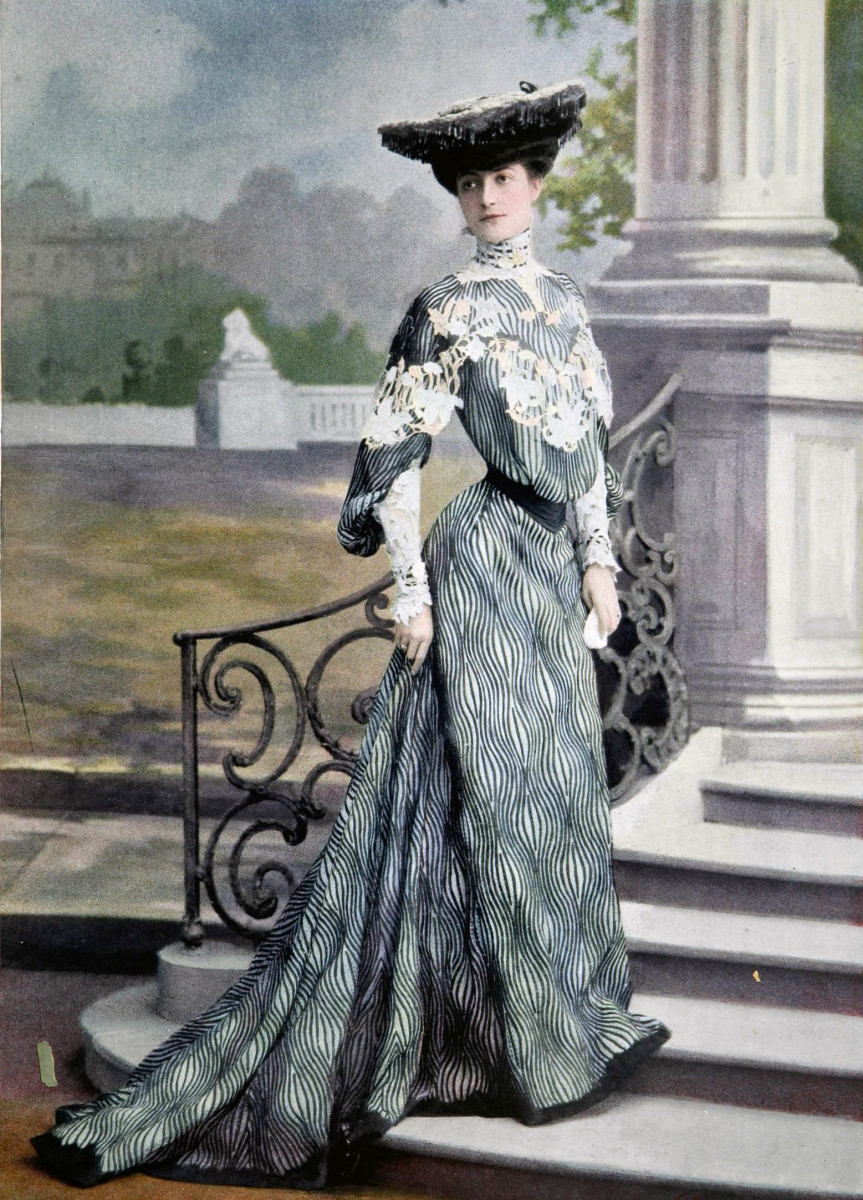Lecture Summary
This week during the lecture we covered the time between 1895 and 1905, a time period which is characterized by the immense progress in the arts and design . For example, during this time we see art nouveau rise from the ashes which the arts and crafts movement left behind. Art nouveau took many aesthetique inspiration from the arts and crafts movement which is seen through their shared usage of organic lines and geometric shapes. However they differed in their philosophy, the arts and crafts movement was a push against industrialization and mass production whereas art nouveau embraced it. Important figures in this movement include
Antoni Horta and most famously, Alphonse Mucha. Other notable movements which we see are the secessionist movement which was inspired by the work of the Gaglslow Four (a group of groundbreaking artists from the Gagslow School). This movement included artists such as Gustav Klimpt.
Research – Edwardian Fashion
As always, fashion is much more than the garments which we use to clothe ourselves. It is the a time capsule to its era, an expression of values, influences, and ideals. A time and place fashion is a product of its time, and is affected by the the context in which it was placed.
Edwardian fashion for example, is an example example of this phenom. The major driving force at the time was the industrial revolution, which was in full swing, sending Europe headfirst into a totally foreign world.The revolution came with several effects, including the creation of the middle class, and the facilitation of garment making.Additionally, the creation of the sewing machine greatly facilitated the process of making garment and consequently resulted in a boom of clothing which was created from factories.
As a result, the newly created middle class could enjoy a new range of benefits which normally would have been reserved for the wealthy. Literacy rates, leisure time and money all increased due the effects of the industrial revolution which contributed to a culture which was capable of interesting themselves with other things.With the world which once was turned on its head, the role of its citizens was placed in a , especially women. The world began to stray from its strict Victorian ways, seeking out luxury, opulence and the lifestyle of the elite, such as the British Monarch Charles
The Gibson Girl – An Icon

To create a clearer picture of the aesthetic ideals of the time, we can take Charles Dana Gibson illustrations of the unnamed women as the icons/role models of this movement in fashion. “The Gibson Girl”, as she was commonly referred to, was portrayed as bold, and fun loving, all while retaining a cool sophistication. She was the icon of the century and embodied all the elements which the fashion savvy copied.

Charles Dana Gibson’s illustration of the Gibson girl was the icon of the Edwardian period and exemplifies its traits, as well as the the figure which was sought after. These elements include her long, slender neck, small waist with an ample bust and hips and her iconic hair-do.

Pigeons??

One notable changes in this style was the silhouette, mostly due the change in corsets. Victorian fashion favoured the hourglass figure, whereas the Edwardian era leaned towards a soft s curve. In order to achieve this, “S-bend Corsets” (also known as “straight-back corsets, and “health corsets”) were popularised. Unlike the Victorian corsets, s bend corsets pushed the chest forward and the hips backwards and “promoted a proud posture”. The corset did not divide up the bust and created a “monobosom” (think pigeon) which was considered fashionable.

Skirts
The shape of skirt also changed during the Edwardian era of fashion,as styles such as the bustles of the Victorian Era reached their death. 2 pieced garments were the most common, with skirts that cinched in the waist and flared as they reached the group. The new style of skirts created a lily or a trumpet silhouette. In 1901 skirts embellished with ruffled lace or fabric were also popular. The silhouette of the skirts began to change in 1904, the shape was made fuller and clung less to the hips, and as 1905 approached skirts began to gently fold inwards. Along with this trend, the waist line of these dresses began to rise until 1907. However, throughout the entire period skirts did retain their length of their Victorian counterparts (often (often brushing the floor) but as time passed trains became more and more common (even for everyday attire!) . Tailored jackets were commonly paired with skirts, and they first began to appear in the 1880’s and increased in popularity until their peak in early 1900’s.
Sources
*https://bellatory.com/fashion-industry/FashionHistoryEdwardianFashionTrends1890s1914
* http://www.fashion-era.com/la_belle_epoque_1890-1914_fashion.htm
https://www.google.ca/search?rlz=1C1CHBD_en-GBCA752CA752&ei=xKbSW-zhGoKz0PEPndO8iAo&q=s+bend+corset&oq=s+bend+corset&gs_l=psy-ab.3..0i67k1j0l3j0i22i30k1l6.3349.5375.0.5482.14.14.0.0.0.0.108.1006.12j1.14.0….0…1.1.64.psy-ab..0.14.1091.6..35i39k1j0i131k1j0i20i263k1j0i10k1.87.3SH5TerwqyQ
Photo Credit
(in order from beginning to first)
* https://en.wikipedia.org/wiki/Gibson_Girl
* https://www.loc.gov/exhibits/gibson-girls-america/
* https://www.google.ca/url?sa=i&source=images&cd=&ved=2ahUKEwih2OekrqPeAhUrFjQIHfcPD6EQjxx6BAgBEAI&url=https%3A%2F%2Flibrary.austintexas.gov%2Fblog-entry%2Fforgotten-fashion-icons-364483&psig=AOvVaw3pv-_sdT2DH8k1uizLpOjU&ust=1540617456454047
* https://bellatory.com/fashion-industry/FashionHistoryEdwardianFashionTrends1890s1914
* https://www.mnn.com/earth-matters/animals/stories/18-most-bizarre-pigeon-breeds